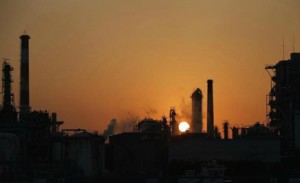Asia set for biggest refining capacity jump in three years
SINGAPORE (Reuters) -- Asia will post its biggest net refining capacity addition in three years in 2017, further boosting demand for crude in the world's biggest and fastest growing oil consuming region.
New and expanded refineries from China to India will offset closures in Japan, adding a net 450,000 bpd of crude processing capacity in 2017, the highest since 2014, energy consultancy Wood Mackenzie says.
The increase amounts to about an additional 1.5 percent of refining capacity on top of Asia's total installed capacity of nearly 29 million bpd, Thomson Reuters Eikon data shows.
"Heavy crude demand in particular is expected to rise in 2017 as more Asian facilities undergo upgrading and new ... refineries come online," said Sushant Gupta, WoodMac's Asia research director for refining.
The rise in capacity will tighten Asia's crude market as it coincides with planned output cuts by oil producers like the Organization of Petroleum Exporting Countries (OPEC) and Russia in a bid to end oversupply and prop up prices.
China National Offshore Oil Corp (CNOOC) plans to start a new 200,000-bpd refinery in southern China, while PetroChina aims to start a 260,000-bpd refinery in Yunnan, pending talks with the Myanmar government.
Chinese independent refiners are also expected to import an extra 200,000-400,000 bpd of crude, research consultancy Energy Aspects estimates, and an upgrade by Taiwan's CPC at its Talin refinery will raise crude and condensate demand by 100,000 bpd.
Vietnam is due to complete a new 200,000-bpd refinery , while India's Bharat Petroleum Corp Ltd is trialing an expansion in Kochi that will include a new 210,000-bpd crude oil distillation unit.
These additions will more than offset a 400,000 bpd decline in refining capacity in Japan by early April due to shrinking local demand, according to Wood Mackenzie.
To meet Asian demand, Iraq has already inked new Basra Heavy deals, while Iran expects to complete a pipeline and terminal to export heavy crude West Kharoon next year.
Kuwait said it is preparing to restart production from oilfields jointly operated with Saudi Arabia.
"We expect a slow ramp up of production from mid-2017. Both Saudi Arabia and Kuwait will have to manage this growth within their agreed OPEC production cuts," WoodMac's Gupta said.
Still, traders see no outright supply shortage for Asian refineries, as OPEC is shielding most of its Asian customers from the planned cuts.
Alternative crude supplies are also available, including heavy crude from Latin America and Angola, as well as shale supplies from the United States.
Reporting by Florence Tan; Editing by Henning Gloystein and Richard Pullin
Related News
- Michelin, IFPEN and Axens announce successful progress in BioButterfly™ R&D project to produce biobased butadiene from bioethanol
- RCI, nova-Institut unveil new carbon label for products, intermediates and raw materials
- Methanol Reformer to supply Mitsubishi Gas Chemical with L18 methanol reformer technology







Comments